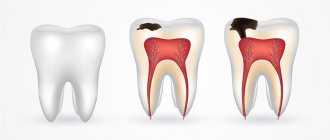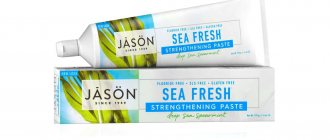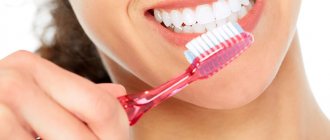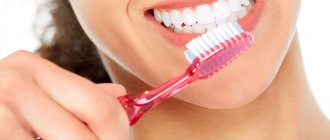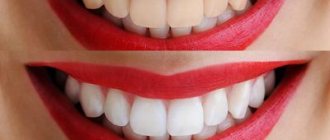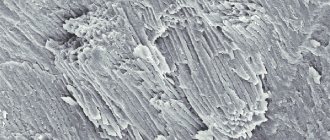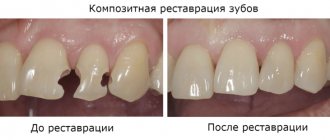Author of the article:
Soldatova Lyudmila Nikolaevna
Candidate of Medical Sciences, Professor of the Department of Clinical Dentistry of the St. Petersburg Medical and Social Institute, Chief Physician of the Alfa-Dent Dental Clinic, St. Petersburg
Many people cannot imagine their morning without a hot, invigorating drink. It seems that coffee can work wonders and literally bring you back to life. Gradually, the body gets used to any influence, therefore, in order to invigorate, more and more cups of this fragrant savior are required. But at some point we notice that the teeth acquire an increasingly intense yellow, and in some places even a brown tint.
What to do? Sound the alarm? Give up your favorite drink? Or should you put up with the picturesque patterns on your tooth enamel and just stop smiling?
All this, of course, is not an option. Moreover, today there are many ways to maintain healthy and white teeth without changing your habits. Let's figure out how coffee affects teeth, consider the most popular and effective methods that help get rid of plaque.
Why does coffee make teeth yellow?
Tooth enamel has a porous structure, so various pigments, which are found in abundance in some products, easily penetrate into it. Due to the deposition of chromogens (coloring molecules) on the surface of the teeth, unsightly stains form. In addition, tannins—tannins—affect the coloring of enamel. They are found in coffee, tea, wine and other products. The effectiveness of dye penetration depends not only on the color of the food, but also on its acidity.
In addition, temperature is a contributing factor. Heat causes the tooth to expand and it becomes even easier for dyes to penetrate the enamel.
Gradually, the tannins contained in coffee accumulate and form a yellow coating. With good oral hygiene this happens more slowly; high-quality specialized pastes can remove up to 90% of stains. And yet, yellowness will appear due to scratches on the enamel and the presence of hard-to-reach places. Therefore, to clean it, periodic office cleaning will be required. Depending on the care and characteristics of the body, the need for procedures occurs once or twice a year.
Why is coffee stains on teeth harmful?
Coffee plaque itself may seem like just a cosmetic problem, but in reality it poses many dangers to the health of your teeth. Coffee contains substances such as sugars, for example, which form a breeding ground for bacteria in the oral cavity. They and their waste products cause the development of caries and inflammation of the tissue, as well as an increase in the amount of plaque. Its further mineralization leads to the appearance of tartar, which changes the structure of the enamel and injures the gums.
Because of the fault
Those with snow-white smiles have to be on their guard when dining. Yakub Abdullaev notes that even white wine has a negative effect on the color of teeth, as it contains tannins. And red is even more so one of the most colorful drinks.
Dentist-periodontist Daria Shikina advises that when drinking such wines, do not keep the liquid in your mouth for a long time, but swallow it immediately: the less the drink comes into contact with the teeth, the less staining. This also applies to strong tea. By the way, according to experts, tea has a more pronounced coloring effect than coffee, again, due to the greater amount of tannins. Both of these drinks should be consumed with milk, which significantly reduces their negative impact on the color of the enamel.
All fruits that leave hard-to-remove stains on clothes can stain your teeth - strawberries, blackberries, blueberries, raspberries, grapes, pomegranates, cherries, black currants, blueberries. Everyone's favorite citrus and tropical fruits are also very insidious. Tomatoes, carrots and beets can change the color of your smile. Dentists point out that tomato sauce has a more pronounced coloring effect than the vegetable itself. Consuming soy sauce, turmeric or curry also harms the color of teeth.
It doesn’t hurt to think about whether we really need carbonated drinks? The pigments they contain stain the teeth, and the high sugar content contributes to the occurrence of caries. To avoid contact with teeth as much as possible, dentists advise enjoying sweet soda with a straw. Green smoothies and fruit juices are also best drunk through a straw.
Photo: depositphotos/belchonock
How to remove coffee stains from teeth at home
The best prevention of the formation of coffee plaque and tartar is comprehensive regular oral hygiene.
Daily Cleaning
Using a brush is a great way to mechanically remove accumulated plaque before it turns to tartar. Cleaning should be done at least twice a day, and, if possible, after each significant meal (breakfast, lunch, dinner).
There should be about 20 movements for each tooth. First, clean the outer side of plaque: turn the brush in the direction from the gums to the cutting edge, then polish the enamel in a circular motion. Then move on to the chewing surface and the inner edge of the lateral teeth. After everything, clean your tongue and rinse your mouth thoroughly. This procedure will not only get rid of plaque, but also prevent the appearance of stones.
Dental floss
Thread (floss) will help remove deposits in places that are difficult for a brush to reach. Stretch it between your index fingers and carefully insert it into the space between the teeth, removing plaque with progressive movements.
Toothpaste
To make daily removal of plaque and yellowness as effective as possible, use specialized pastes. For example, “ASEPTA PLUS” COFFEE AND TOBACCO. It will help maintain a white smile, eliminate the negative effects of smoking and drinking coffee, and provide fresh breath.
Advantages of ASEPTA PLUS:
- Highly active abrasives will carefully and effectively whiten enamel, giving long lasting results.
- plant extracts will speed up the recovery process and soothe the gums;
- fragrances will make your breath fresh.
How does coffee affect enamel?
Yes, the aromatic drink spoils the tone of the enamel. But this happens from several large cups drunk per day, combined with neglect of the rules of oral hygiene. Then the plaque on your teeth from coffee is guaranteed. If coffee lovers are also addicted to smoking, this further aggravates the situation. Everyone should know that the color of enamel is different for all people, and a yellowish tint may well be natural. The top layer of the crowns itself is porous, but in some it is weakly expressed, while in others it is stronger. The higher the degree of porosity, the greater the risk of darkening. However, some people have completely smooth teeth by nature. Such units, of course, are practically not painted.
The temperature of the invigorating drink also affects yellowing. After all, when hot, hard tissues expand, pores become larger, and the enamel darkens faster. In addition, the acidity of the grain variety exacerbates the problem. Coffee made from more acidic beans destroys crowns more. Pigments actively settle on damaged areas. What to do in such conditions? We offer our patients ultrasonic dental plaque removal. This is a popular technique today, as it is safe compared to chemical and mechanical technologies. It gives crowns a natural shade by restoring it. As a result, the units become several shades lighter. It certainly looks attractive.
Clinical researches
Clinical studies have proven that regular use of professional toothpaste ASEPTA COFFEE AND TOBACCO for a month improved the hydration of the mucous membrane by 3.3 times, the remineralizing efficiency increased by 3.9 times, at the same time, the cleansing effect has increasing dynamics and reaches 60 .5% at 4 weeks of use.
Sources:
- Report on determining/confirming the preventive properties of toothpaste “ASEPTA PLUS” COFFEE and TOBACCO Author: doctor-researcher A.A. Leontyev, head Department of Preventive Dentistry, Doctor of Medical Sciences, Professor S.B. Ulitovsky. First St. Petersburg State Medical University named after. acad. I.P. Pavlova, Department of Preventive Dentistry
- Report on determining/confirming the preventive properties of toothpaste “ASEPTA PLUS” GENTLE WHITENING” Author: doctor-researcher A.A. Leontyev, head Department of Preventive Dentistry, Doctor of Medical Sciences, Professor S.B. Ulitovsky First St. Petersburg State Medical University named after. acad. I.P. Pavlova, Department of Preventive Dentistry
- Clinical and laboratory assessment of the influence of domestic therapeutic and prophylactic toothpaste based on plant extracts on the condition of the oral cavity in patients with simple marginal gingivitis. Doctor of Medical Sciences, Professor Elovikova T.M.1, Candidate of Chemical Sciences, Associate Professor Ermishina E.Yu. 2, Doctor of Technical Sciences Associate Professor Belokonova N.A. 2 Department of Therapeutic Dentistry USMU1, Department of General Chemistry USMU2
- Report on the determination/confirmation of the preventive properties of personal oral hygiene products “ASEPTA PLUS” Remineralization doctor-researcher A.A. Leontyev, head Department of Preventive Dentistry, Doctor of Medical Sciences, Professor S.B. Ulitovsky First St. Petersburg State Medical University named after. acad. I.P. Pavlova, Department of Preventive Dentistry
- Clinical studies of antisensitive toothpaste “Asepta Sensitive” (A.A. Leontyev, O.V. Kalinina, S.B. Ulitovsky) A.A. LEONTIEV, dentist O.V. KALININA, dentist S.B. ULITOVSKY, Doctor of Medical Sciences, Prof. Department of Therapeutic Dentistry, St. Petersburg State Medical University named after. acad. I.P. Pavlova
- The role of anti-inflammatory rinse in the treatment of periodontal diseases (L.Yu. Orekhova, A.A. Leontyev, S.B. Ulitovsky) L.Yu. OREKHOVA, Doctor of Medical Sciences, Prof., Head of Department; A.A. LEONTIEV, dentist; S.B. ULITOVSKY, Doctor of Medical Sciences, Prof. Department of Therapeutic Dentistry of St. Petersburg State Medical University named after. acad. I. P. Pavlova
Benefits of coffee for teeth
If coffee consumption is limited to one or two cups per day, it will benefit the teeth by reducing the development of caries. There are statistical data that state that coffee beans in light and medium roast varieties of Arabica and Robusta contain catechin, which blocks the development of streptococci (Streptococcus Mutans), which create conditions during their life for the occurrence of caries. It is worth noting that coffee should be drunk in its pure form, without sugar and milk, which also contains lactose, which leads to the proliferation of microbes and the development of tartar and caries. Another benefit of coffee is to reduce the risk of oral cancer thanks to the phytoncides in its composition.
How to drink correctly
There are several important tips on how to drink coffee to prevent your teeth from yellowing:
- drink only Americano or add milk or cream to the drink;
- Before drinking espresso, let it cool, hot water damages the enamel.
- after drinking any coffee drink, rinse your mouth with special rinses or at least warm water;
- Use professional products to clean your teeth.
These simple rules will reduce the harm of the coloring pigment.
Coffee and healing procedures
After filling or implants, there are usually no restrictions on drinking espresso, but be sure to consult with your doctor.
Interesting! How much caffeine is in a cup of coffee
But keep in mind that the filling material may be stained. Especially at first. Therefore, it is better to refrain from pure coffee. It is better to add milk during the day.
After tooth extraction, you can drink coffee within a few hours. But it is important to remember that it must be warm.
But before removal, drinking the drink is prohibited. This is due to the fact that caffeine weakens the effect of anesthesia.
Causes of plaque on teeth
The main risk factors for deposit formation are:
- Lack of oral hygiene;
- Incorrect selection of cleaning products;
- Excessive consumption of simple carbohydrates (sweets, baked goods, carbonated drinks, sugar, etc.);
- Predominance of soft foods in the diet, lack of hard foods;
- Drinking coloring drinks, including coffee and tea;
- The presence of fillings, dentures, braces and other orthodontic structures;
- Chips, cracks and other damage to the dentofacial apparatus;
- Smoking;
- Individual properties of saliva;
- Intensity of chewing food;
- Diseases of the gastrointestinal tract;
- Diseases with metabolic disorders;
- Congenital and acquired defects or anomalies of the dentofacial apparatus;
- Long-term treatment with antibacterial drugs.
Another reason why plaque appears can be improper brushing of teeth. Oral hygiene should include not only the front surface of the teeth, but also the back, as well as the tongue. Hard-to-reach spaces can be cleaned using thread.
Is it possible to drink coffee immediately after brushing and whitening your teeth and how much should you not?
White teeth after brushing, won't coffee hurt?
- To maintain a snow-white smile for as long as possible after teeth whitening, avoid any products that can stain your teeth.
- Since coffee contains natural dyes, avoid drinking it for 2 days. Subsequently, for 2 weeks, reduce the consumption of your favorite drink to a minimum.
- After this time, you can return to your normal routine of enjoying aromatic coffee.
Traditional methods
Cleaning the front and back teeth from plaque can be done at home. For these purposes, non-traditional methods are used. The use of the described cleaning methods is not recommended if you have toothaches, at a late stage of caries, or with gum inflammation.
If gray plaque appears on your teeth, use the following cleaning methods:
- Soda. The procedure should be carried out no more than 2 times a week. Instead of toothpaste, apply a small amount of baking soda to your brush and use it to brush your teeth. At the same time, you should try not to wet the soda so that its effect is not neutralized by water.
- Activated carbon . For cleaning, 2 charcoal tablets are crushed and then used instead of toothpaste. Coal particles act as an abrasive that cleans the enamel of contamination. The procedure should be carried out 2-3 times a week to prevent damage to the enamel.
- Hydrogen peroxide. After daily brushing with toothpaste, you should rinse your mouth with peroxide. After this, the liquid is spat out and rinsed again with warm water. After this, it is recommended to wipe your teeth with a clean towel or napkin.
- Wood ash. Use toothpaste to remove plaque. Before each brushing of your teeth, you should dip your brush into a container of ash. It can also be combined with powder or regular paste. The procedure should be performed with low intensity so as not to damage the enamel or gums.
Important to remember! Home methods for removing soft deposits are less effective than professional cleaning, so it is best to carry out hygiene procedures in a dental clinic.
